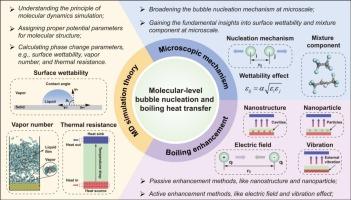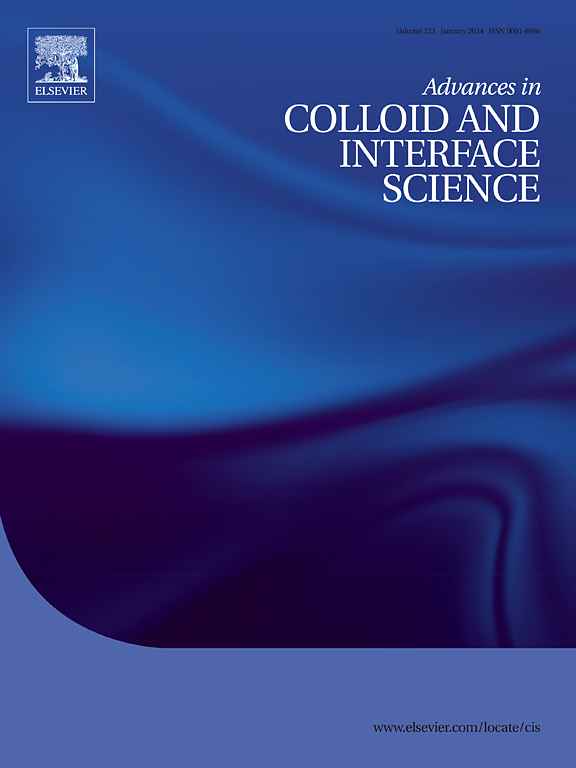分子动力学模拟在气泡成核和沸腾传热方面的最新进展:最新进展综述。
IF 19.3
1区 化学
Q1 CHEMISTRY, PHYSICAL
引用次数: 0
摘要
沸腾传热在各种工业领域的重要性日益凸显,但其中涉及的混沌性质现象在实验上仍具有挑战性。从成核的角度来看,气泡胚胎在早期出现的时间和长度尺度都非常小。因此,分子动力学(MD)模拟是在微观尺度上揭示独特沸腾机制的一种流行而有用的工具。近来,这种方法取得了有意义的成果,但复杂沸腾过程背后的现状和瓶颈仍然难以捉摸。本文全面回顾了截至 2024 年的 129 篇关于气泡成核和沸腾传热的最新研究成果。同时,简要介绍了 MD 的基本概念,包括 MD 原理、力场和成核相关参数的确定。与微观沸腾不同,气泡成核源于微/纳米尺度上势能和动能之间的竞争。然后,深入阐明了气泡成核的关键因素,如界面润湿性和混合物成分。此外,还系统地讨论了被动和主动技术,以揭示沸腾传热增强的内在机制。最后,确定了 MD 模拟所需的持续试验,并展望了如何应对这些挑战。本综述旨在对沸腾机理进行最新总结,并引起人们对先进 MD 技术发展的更多关注。本文章由计算机程序翻译,如有差异,请以英文原文为准。

Recent advances of molecular dynamics simulation on bubble nucleation and boiling heat transfer: A state-of-the-art review
Boiling heat transfer has become increasingly importance in a variety of industrial fields, but it involves chaotic nature phenomena that remain experimentally challenging. From the perspective of nucleation, bubble embryos emerge at the early stage on extremely small time and length scales. Therefore, molecular dynamics (MD) simulation is a popular and useful tool to uncover the distinctive boiling mechanisms at microscale. Recently, such method has yielded meaningful achievements, but there is still elusive on the current status and bottlenecks behind complex boiling processes. In this work, the state-of-the-art studies on bubble nucleation and boiling heat transfer that covers 129 papers up to 2024 have been comprehensively reviewed. Meanwhile, fundamental concepts of MD are briefly introduced, including MD principles, force fields, and determination of nucleation-related parameters. In contrast to microscopic boiling, bubble nucleation stems from the competition between potential and kinetic energies on micro/nano scale. Then, the key factors such as interfacial wettability and mixture component are thoroughly elucidated for bubble nucleation. In addition, both passive and active techniques are systematically discussed to unveil the underlaying mechanisms for boiling heat transfer enhancement. Finally, the ongoing trials needed for MD simulation are identified, together with an outlook for how to address these challenges. This review aims to offer an up-to-date summary of boiling mechanisms and draw more attention to the development of advanced MD techniques.
求助全文
通过发布文献求助,成功后即可免费获取论文全文。
去求助
来源期刊
CiteScore
28.50
自引率
2.60%
发文量
175
审稿时长
31 days
期刊介绍:
"Advances in Colloid and Interface Science" is an international journal that focuses on experimental and theoretical developments in interfacial and colloidal phenomena. The journal covers a wide range of disciplines including biology, chemistry, physics, and technology.
The journal accepts review articles on any topic within the scope of colloid and interface science. These articles should provide an in-depth analysis of the subject matter, offering a critical review of the current state of the field. The author's informed opinion on the topic should also be included. The manuscript should compare and contrast ideas found in the reviewed literature and address the limitations of these ideas.
Typically, the articles published in this journal are written by recognized experts in the field.

 求助内容:
求助内容: 应助结果提醒方式:
应助结果提醒方式:


